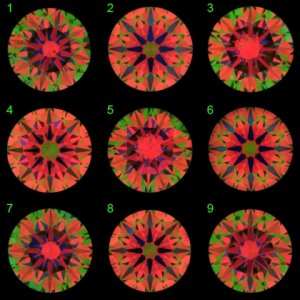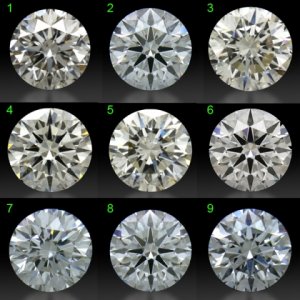- Joined
- May 1, 2008
- Messages
- 3,563
Hello.
The suggestion was made to separate this topic from another, and make a relevant title.
Prior discussion here.
https://www.pricescope.com/communit...g-h-a-1-29-or-larger-pre-loved-ok-too.211774/
You raise many good questions in that thread above. In scanning the replies, I see answers are vacillating between what’s quantifiable at present, and what’s implied by ongoing research but not decisively measurable. Specific to your CBI questions:
This question is key:
Correct. We are not there yet.
Consider this context: Even Tolkowsky’s popular “ideal” proportions waited until 2005 to be verified in a repeatable scientific lab metric. That involves basic brightness, contrast and leakage in a single/static environment. Considering scintillation/motion through infinite illumination scenarios is a whole different beast.
At present no lab metric addresses it. GIA’s cut analysis isn't diamond-specific. AGS quantifies brightness, contrast and leakage but makes no assessment of scintillation. Internet sellers increasingly use structured light environs photos to instill confidence about cut pedigree, but that’s still cold analytics. We can project our own estimate of sparkle-potential based on these things, but the global macro of scintillation - at the level of your question - involves the diamond-in-motion through an infinite number of lighting conditions. The human eye more sophisticated than any study or data-set. Live viewing of a diamond in different environments can’t be replaced by cold analytics.
Another component to this is the human physiology of individual eyesight. Some people have a refined visual palate, others develop one, others don’t. One person may detect more in a diamond’s scintillation than others. That goes for color and clarity too. Some people are crazy color-sensitive while others are not. It’s the same with cut. Furthermore, palates like listening, tasting and seeing rely on live, hot cognition. I don't know if you have perfect pitch, a nose for wine or an eye for diamond nuances. Some people do. Some don’t. Some have one palate that’s more refined than their others… What’s certain is that one person cannot possibly determine the subtle nuances of what another will see (or hear or taste) based on his own palate.
Circling back to quantification.
Back in the late 1800s a small number of cutters with a beauty-first proposition recognized certain angles produced appealing results. Some recognized those angles before Tolkowksy’s book. Others, like his cousin Lazare Kaplan, used his math as a basis for consistent beauty. They did this with more time and expense involved in cutting, and they did it many decades before measurable scientific validation came along and proved “why” their vision was correct. Side note: Many large factories have moved toward better basic proportions-sets in the last decade, but only because GIA released a grading system in 2006 which forced them that way.
Here we are today. A small number of operations with a beauty-first proposition recognize top optical precision resulting in scintillation advantages. There is more time and expense involved in cutting, especially in the fine-tuning skill and tools needed, but we do this because we’re confident our vision is correct.
One day the advantages and limits of this stuff may be quantified. The diamond side will involve ETAS/DETAS and virtual facet theory. However, the physiological particulars may make this as person-specific as it will be diamond-specific. I tip my hat regularly to my friends and pro colleagues engaged in these studies.
Let’s everyone keep in mind that we’re talking about details and nuance, not broad strokes. Nevertheless, they are important to many. There is a rich history of testimonials and knowledge on this site, voicing both “yay” and “nay” about these things. In the real world the most obvious “yay” quantification is the success of Hearts On Fire. There is no way they could exist and flourish without enough people seeing the advantages and voting “yay” with their money. To that end, the in-store experiences of our showroom clients is in-keeping with this. Many decisively see and want our specific look. Others see it but have a different priority. Others may say “meh,” or don’t see it at all.
Nobody is wrong. These perceptions all coexist. Just as happy table-wine folks coexist with connoisseurs … and those wine-in-a-box folks.
The suggestion was made to separate this topic from another, and make a relevant title.
Prior discussion here.
https://www.pricescope.com/communit...g-h-a-1-29-or-larger-pre-loved-ok-too.211774/
Paul’s dance card has been full the past week, but I’ll effort to reply here, pfunk.pfunk|1427992149|3855837 said:Paul, if you are still checking in I would love for you to address the post that I made that quoted several statements from the CBI website regarding the information that is being shared in markets other than the US. If there is more research or information available, as the website seems to suggest, I and others would be interested in it if it is accessible.
You raise many good questions in that thread above. In scanning the replies, I see answers are vacillating between what’s quantifiable at present, and what’s implied by ongoing research but not decisively measurable. Specific to your CBI questions:
See below.-Does this mean there is no way to measure scintillation, or simply that AGSL doesn't measure it?
See below.Does CBI have their own way to measure scintillation, and in doing so, have you found that your diamonds score higher?
This question is key:
pfunk|1427578544|3853845 said:In a nut shell, is there a way to quantify the detrimental effect of sacrificing perfect h&a patterns in diamonds which are cut to AGS 000 performance? Does such a metric exist, or are we not there yet?
Correct. We are not there yet.
Consider this context: Even Tolkowsky’s popular “ideal” proportions waited until 2005 to be verified in a repeatable scientific lab metric. That involves basic brightness, contrast and leakage in a single/static environment. Considering scintillation/motion through infinite illumination scenarios is a whole different beast.
At present no lab metric addresses it. GIA’s cut analysis isn't diamond-specific. AGS quantifies brightness, contrast and leakage but makes no assessment of scintillation. Internet sellers increasingly use structured light environs photos to instill confidence about cut pedigree, but that’s still cold analytics. We can project our own estimate of sparkle-potential based on these things, but the global macro of scintillation - at the level of your question - involves the diamond-in-motion through an infinite number of lighting conditions. The human eye more sophisticated than any study or data-set. Live viewing of a diamond in different environments can’t be replaced by cold analytics.
Another component to this is the human physiology of individual eyesight. Some people have a refined visual palate, others develop one, others don’t. One person may detect more in a diamond’s scintillation than others. That goes for color and clarity too. Some people are crazy color-sensitive while others are not. It’s the same with cut. Furthermore, palates like listening, tasting and seeing rely on live, hot cognition. I don't know if you have perfect pitch, a nose for wine or an eye for diamond nuances. Some people do. Some don’t. Some have one palate that’s more refined than their others… What’s certain is that one person cannot possibly determine the subtle nuances of what another will see (or hear or taste) based on his own palate.
Circling back to quantification.
Back in the late 1800s a small number of cutters with a beauty-first proposition recognized certain angles produced appealing results. Some recognized those angles before Tolkowksy’s book. Others, like his cousin Lazare Kaplan, used his math as a basis for consistent beauty. They did this with more time and expense involved in cutting, and they did it many decades before measurable scientific validation came along and proved “why” their vision was correct. Side note: Many large factories have moved toward better basic proportions-sets in the last decade, but only because GIA released a grading system in 2006 which forced them that way.
Here we are today. A small number of operations with a beauty-first proposition recognize top optical precision resulting in scintillation advantages. There is more time and expense involved in cutting, especially in the fine-tuning skill and tools needed, but we do this because we’re confident our vision is correct.
One day the advantages and limits of this stuff may be quantified. The diamond side will involve ETAS/DETAS and virtual facet theory. However, the physiological particulars may make this as person-specific as it will be diamond-specific. I tip my hat regularly to my friends and pro colleagues engaged in these studies.
Let’s everyone keep in mind that we’re talking about details and nuance, not broad strokes. Nevertheless, they are important to many. There is a rich history of testimonials and knowledge on this site, voicing both “yay” and “nay” about these things. In the real world the most obvious “yay” quantification is the success of Hearts On Fire. There is no way they could exist and flourish without enough people seeing the advantages and voting “yay” with their money. To that end, the in-store experiences of our showroom clients is in-keeping with this. Many decisively see and want our specific look. Others see it but have a different priority. Others may say “meh,” or don’t see it at all.
Nobody is wrong. These perceptions all coexist. Just as happy table-wine folks coexist with connoisseurs … and those wine-in-a-box folks.









300x240.png)